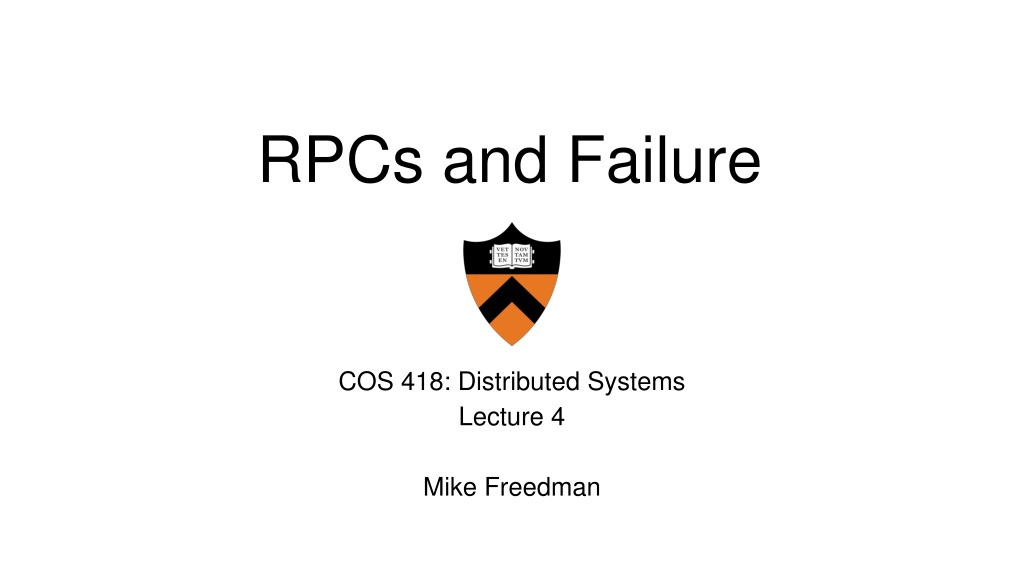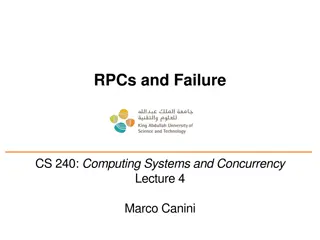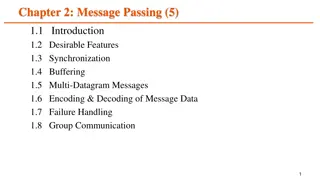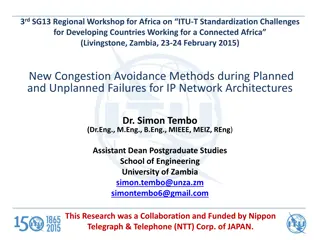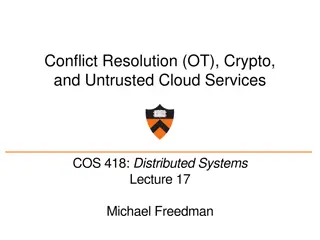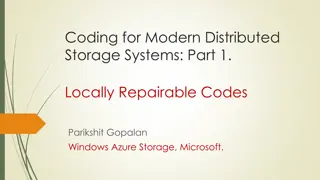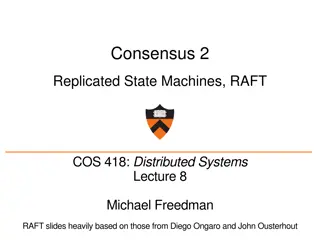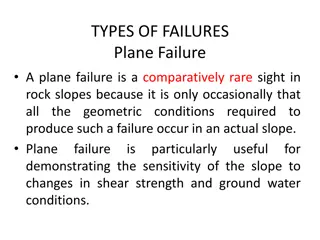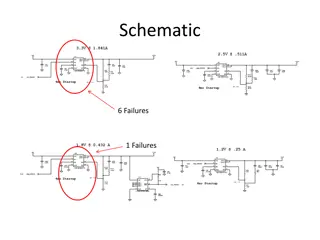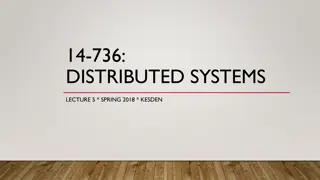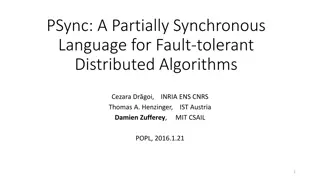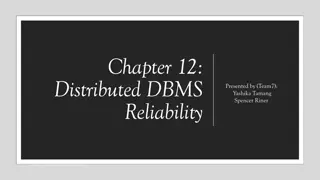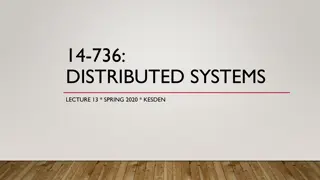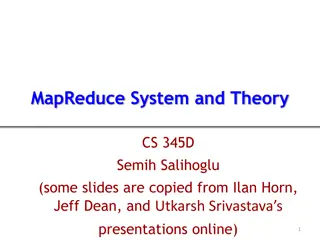Handling Failures in Distributed Systems
Distributed systems face various challenges like crashes, packet loss, slow networks, and hidden failures from a client's perspective. The At-Least-Once scheme is discussed, highlighting its simplicity and possible side effects in operations like debit transactions and key-value pair storage. The suitability of the At-Least-Once approach for read-only operations is emphasized.
Download Presentation

Please find below an Image/Link to download the presentation.
The content on the website is provided AS IS for your information and personal use only. It may not be sold, licensed, or shared on other websites without obtaining consent from the author. Download presentation by click this link. If you encounter any issues during the download, it is possible that the publisher has removed the file from their server.
E N D
Presentation Transcript
RPCs and Failure COS 418: Distributed Systems Lecture 4 Mike Freedman
Last Time: RPCs and Network Comm. Layers are our friends! RPCs are everywhere Necessary issues surrounding machine heterogeneity Application layer Application layer Process Process RPC Layer RPC Layer Socket Socket Transport layer Transport layer Network layer Network layer Link layer Link layer Physical layer Physical layer Host A Host B Subtle issues around failures this time!!! 2
What could possibly go wrong? 1. Client may crash and reboot All of these may look the same to the client 2. Packets may be dropped Some individual packet loss in the Internet Broken routing results in many lost packets 3. Server may crash and reboot 4. Network or server might just be very slow 3
Failures, from clients perspective Server Client Time The cause of the failure is hidden from the client! 4
At-Least-Once scheme Simplest scheme for handling failures 1. Client stub waits for a response, for a while Response is an acknowledgement message from the server stub 2. If no response arrives after a fixed timeout time period, then client stub re-sends the request Repeat the above a few times Still no response? Return an error to the application 5
At-Least-Once and side effects Client sends a debit $10 from bank account RPC Server Client (debit $10) (debit $10) Time 6
At-Least-Once and writes Consider a client storing key-value pairs in a database put(x, value), then get(x): expect answer to be value put(x,10) put(x,20) Server Client x 10 x 20 x=20 Time 7
At-Least-Once and writes Consider a client storing key-value pairs in a database put(x, value), then get(x): expect answer to be value put(x,10) put(x,20) Server Client x 10 x 20 x=20 x 10 Time 8
So is At-Least-Once ever okay? Yes: If they are read-only operations with no side effects e.g., read a key s value in a database Yes: If the application has its own functionality to cope with duplication and reordering You will need this in Assignments 3 onwards 9
At-Most-Once scheme Idea: server RPC stub detects duplicate requests Returns previous reply instead of re-running handler How to detect a duplicate request? Test: Server stub sees same function, same arguments twice No! Sometimes applications legitimately submit the same function with same augments, twice in a row 10
At-Most-Once scheme How to detect a duplicate request? Client stub includes unique transaction ID (xid) with each RPC request Client stub uses same xid for retransmitted requests At-Most-Once Server Stub if seen[xid]: retval = old[xid] else: retval = handler() old[xid] = retval seen[xid] = true return retval 11
At-Most-Once: Providing unique XIDs 1. Combine a unique client ID (e.g., IP address) with the current time of day 2. Combine unique client ID with a sequence number Suppose client crashes and restarts. Can it reuse the same client ID? 3. Big random number (probabilistic, not certain guarantee) 12
At-Most-Once: Discarding server state Problem: seen and old arrays will grow without bound Observation: By construction, when the client gets a response to a particular xid, it will never re-send it Client could tell server I m done with xid x delete it Have to tell the server about each and every retired xid Could piggyback on subsequent requests Significant overhead if many RPCs are in flight, in parallel 13
At-Most-Once: Discarding server state Problem: seen and old arrays will grow without bound Suppose xid = unique client id, sequence no. e.g., 42, 1000 , 42, 1001 , 42, 1002 Client includes seen all replies X with every RPC Much like TCP sequence numbers, acks How does client know the server received the info about retired RPCs? Each one of these is cumulative: later seen messages subsume earlier ones 14
At-Most-Once: Concurrent requests Problem: How to handle a duplicate request while the original is still executing? Server doesn t know reply yet. And we don t want to run procedure twice Idea: Add a pending flag per executing RPC Server waits for the procedure to finish, or ignores 15
At-Most-Once: Server crash and restart Problem: Server may crash and restart Does server need to write its tables to disk? Yes! On server crash and restart: If old[], seen[] tables are only in memory: Server will forget, accept duplicate requests 16
Exactly-once? Need retransmission of at least once scheme Plus the duplicate filtering of at most once scheme To survive client crashes, client needs to record pending RPCs on disk So it can replay them with the same unique identifier Plus story for making server reliable Even if server fails, it needs to continue with full state To survive server crashes, server should log to disk results of completed RPCs (to suppress duplicates) 17
Exactly-once for external actions? Imagine that remote operation triggers an external physical thing e.g., dispense $100 from an ATM ATM could crash immediately before or after dispensing ATM would lose its state, and Don t know which one happened (although can make window very small) Can t achieve exactly-once in general, in presence of external actions
Summary: RPCs and Network Comm. Layers are our friends! RPCs are everywhere Help support machine heterogeneity Application layer Application layer Process Process RPC Layer RPC Layer Socket Socket Transport layer Transport layer Network layer Network layer Link layer Link layer Physical layer Physical layer Subtle issues around failures At-least-once w/ retransmission At-most-once w/ duplicate filtering Discard server state w/ cumulative acks Exactly-once with: at-least-once + at-most-once + fault tolerance + no external actions Host A Host B 19
